
| Added | Sun, 18/12/2016 |
| Источники |
There are a large number of phenomena, manifested exclusively when shooting a camera or camcorder, but it is inaccessible to human senses. These phenomena include Kittery, plasmoids, flying rods, memory fields, etc. All these phenomena is extremely popular among researchers of the paranormal phenomena: in the Internet you can find a huge number of photos related to any of them; the forums are still fierce disputes about their nature; expeditions take place in places that often get anomalous photos. There are even recognized by many of the anomalous zonein which these phenomena occur most frequently.
But why in the photos is evident that is not visible to the human naked eye? The most common is the following explanation:
Quote:
"The human eye sees only a narrow part of the electromagnetic spectrum. On either side of the visible range of frequencies lying area, inaccessible to our direct perception. We don't know what (or who) they are. In order to get there, you need to use special devices, such as cameras, sensitivity range which is wider than the human eye. With their help, we may be able to detect there is a world that exists parallel to ours."
The explanations often differ in what lies beyond our sight: someone was talking about live (and some even sentient) beings, someone on a parallel reality, and some of the mirages or holograms, somehow reproducing the events of the past. In this article we will not deal with specific hypotheses, and will try to find out in what range can these phenomena are visible.
This article continues a series of publications in which we try to understand whether using the camera to look beyond the face of the ordinary, are there any of these phenomena actually, and if Yes, what is their true cause. For brevity in these articles we combine the phenomena that occur only when a photo or video, the term "polifenolny".
Human vision
We have already published an article devoted to the peculiarities of human vision. We will not repeat it, focus only on those aspects that are important for understanding the further discussion.
Up to 90% of information about the outside world around the person receives from the organs of vision. The human eye is an extremely complex instrument that registered electromagnetic waves with a sensitivity of responding to individual photons.
However, like any precision instrument, the eye only works in a narrow range of values of input parameters. Simply put, the eye allows you to see the electromagnetic waves of a narrow range of frequencies – up to approximately 385-395 750-790 THz (wavelength of from 380-400 to 760-780 nm). This range of frequencies (or wavelengths) of electromagnetic waves is called the "visible range" [1].
It should be noted that the visible range has no clear boundaries. The eye has maximum sensitivity to radiation of frequency 540 THz (wavelength 555 nm). When you delete a frequency from the point of maximum sensitivity of the eye is gradually reduced to zero, and the character of this curve is specific to a person. Thus, to specify the strict boundaries of the visible range is impossible.
For electromagnetic radiation, whose wavelength ranges are directly adjacent to the visible light range, there are special names. Radiation with wavelengths smaller than the lower limit of the visible range are called ultraviolet; with big – infrared. Each of these areas, in turn divided into sub-bands: near, middle and far, depending on the distance to the border of the visible range (table 1, [2]).
Table 1. Visible light and the adjacent wavelength ranges
| The range of wavelengths | 100-280 nm | 280-315 nm | 315-380 nm | 380-780 nm | 780 nm – 1.4 µm | The 1.4-3 µm | 3 µm – 1 mm |
| Name (designation) | The far UV range (UV-C) |
Average UV range (UV-B) |
The middle UV range (UV-A) |
Visible light | The middle IR range (IR-A) |
Mid-IR range (IR-IN) |
The far IR range (IR-C) |
The dependence of the sensitivity of the eye (or other photosensitive element) from the frequency of electromagnetic waves is called spectral sensitivity. The human eye contains two kinds of light receptors: rods and cones. The first is responsible for the perception under reduced illumination (night vision), the second for visual acuity and color vision (daylight vision) [3]. The spectral sensitivity of these receptors are different, sticks its maximum is shifted towards shorter wavelengths. Graphs are normalized to the maximum spectral sensitivity of the human eye for twilight and daylight vision is shown in figure 1.

Figure 1. Graph normalized to the maximum spectral sensitivity of the eye [4]
You must understand that such a sensitive area of the eye selected by nature is not accidental. The visible range of electromagnetic waves falls into one of two transparency Windows of the Earth's atmosphere [5].
The transparency Windows are wavelength ranges in which electromagnetic radiation is not absorbed or is absorbed only slightly. With respect to the earth's atmosphere two transparency Windows: optical (from 300 to 1500-2000 nm) and radio (from 1 mm to 15-30 meters). For all other wavelengths the atmosphere is opaque due to absorption and scattering of radiation by molecules and atoms, as well as the reflection of radio waves from electrons of the ionosphere.
Thus, the human eye responds specifically to those electromagnetic waves that can freely propagate in the Earth's atmosphere. Most of the animals on the planet also see in this frequency range (with minor deviations – for example, the spectral sensitivity of the visual organs of bees is shifted towards the near UV range). This allows you to make vision possible for our planet, which is appropriate both from the point of view of evolution and natural selection, and from the point of view of the theories of creationism.
Spectral sensitivity of cameras
Based on the foregoing, we can conclude that the person really sees only a small portion of the surrounding electromagnetic radiation. It is obvious that, using special tools, it is possible to register a wider range of frequencies.
Traditionally the most accessible it products are defined as cameras and camcorders. It should be borne in mind that in the recent past in the field of photography and videography has witnessed a revolution caused by the widespread proliferation of digital cameras. At a rough estimate we can assume that the vast majority of photos prior to 2001 was done using a film camera, while the photos that emerged after the beginning of XXI century, most of them are digital.
Digital photography, though, and have the same purpose, and film (to record what he sees before him a photographer) use a completely different method of image formation, which leads to differences including the nature of the captured polifenoles.
Speaking about the spectral sensitivity of cameras, usually referring to the combined sensitivity of the system "svetolir-the-lens photosensitive element". Next, we consider the impact of each of these components on the ability to capture pictures in a wider range of frequencies.
Let's start with film cameras and actually film. Typical curves of spectral sensitivity of certain materials used in the manufacture of photographic film, is shown in figure 2.
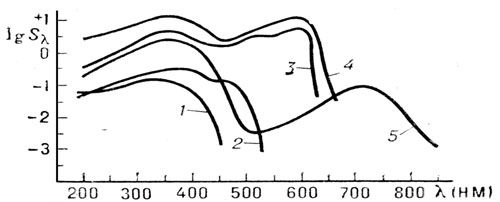
Figure 2. Typical curves of spectral sensitivity of photographic materials: 1 – desencibilizirutee, 2 – sortoprokatnogo, 3 – isoperational, 4 – pan, 5 – infrachromatic.
As can be seen from these curves, the normal photographic film can detect all ultraviolet sub-bands. The results of the survey in the UV range depends on the type of film used [2]:
- black-and-white negative film sees the UV light is the best (apart from the films treated for color process C-41, which are completely indifferent to ultraviolet light, because their sensitivity ends at 380 nm);
- color negative film accepts near and middle UV ranges, the higher the sensitivity (ISO) of the film, the more receptive it is to UV light;
- draw a colored film is not suitable for UV photography, as the curve of its spectral sensitivity depends on the wavelengths of 370-380 nm.
Regular film is not practically perceive light infrared. To create IR photographs using special photographic films, which use iprogrammaticskin photosensitive materials (curve 5 in figure 2). The spectral sensitivity of these films is shown in figure 3 [6].
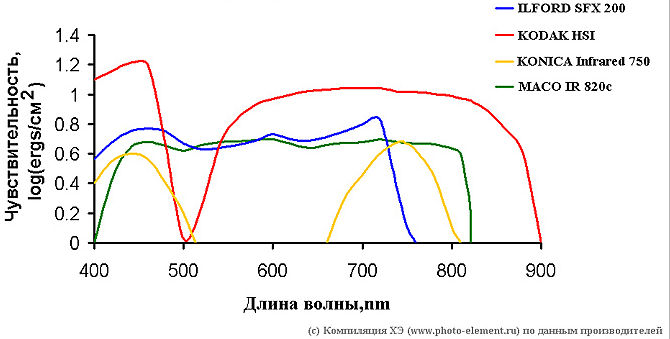
Figure 3. Curves spectral sensitivity of infrared films
From these graphs it is seen that the sensitivity of even the specialized IR film is limited to wavelengths of about 900 nm, i.e. within the near-IR range.
In digital cameras and camcorders light sensitive elements are charge coupled devices – CCDs. CCD image sensors are composed of individual microsensors (pixels) located on a silicon photocell. Spectral sensitivity of silicon solar cells lies in the range between blue and near infrared (figure 4).
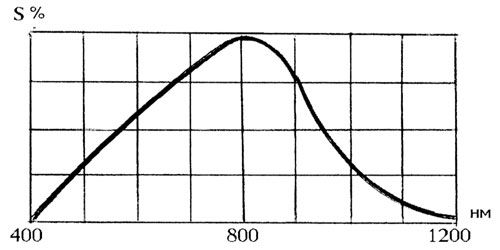
Figure 4. A typical curve of spectral sensitivity of CCD digital camera
The lower limit of the susceptibility matrix of today's digital cameras is the wavelength of around 330 nm, i.e. digital cameras are sensitive only to radiation of near UV range. On top of the CCD sensitivity is limited to wavelengths of about 1.2 microns, i.e., a digital camera can only perceive radiation in the near-IR range.
However, it is not so simple. High sensitivity to IR radiation is a harmful factor for most photographers, because it leads to excessive illumination of the photos. To avoid this, in almost all current digital camera manufacturers install special filters (hot mirror), does not transmit IR radiation. The filter hot mirror of the camera Canon 350D is shown in figure 5.


Figure 5. Filter hot mirror camera Canon 350D: the CCD (left) and separate (right) [7]
The model dependence of the bandwidth of such filters of the wavelength is shown in figure 6.
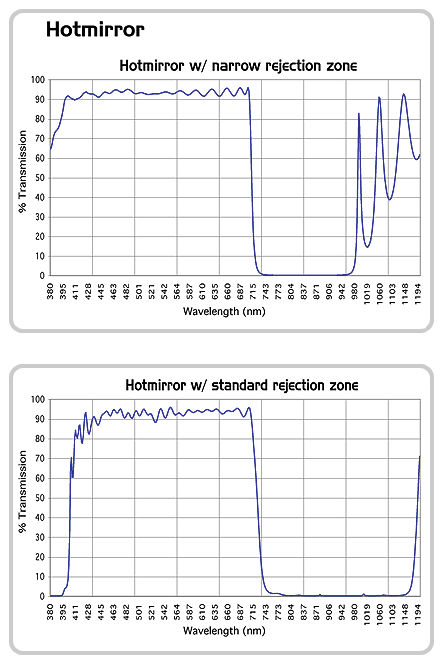
Figure 6. Model capacity hot-mirror filter [8]
As can be understood from the figure, the filter of the hot mirror can only capture infrared radiation (top graph), and does to pass only waves of the visible frequency range (lower graph). To enable photography in the IR (and sometimes UV) range of frequencies the filter is removed. In the original (factory) digital cameras are practically impervious to IR radiation.
Before you get on the sensing element, be it film or CCD, light passes through the lens, which is a complex system of glass lenses. The lens also has impact on the spectral characteristics of passing therethrough radiation. A typical curve bandwidth lens modern cameras are shown in figure 7.
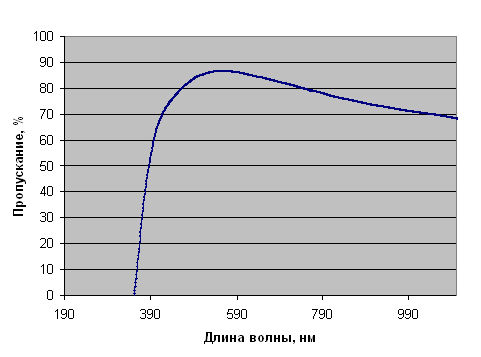
Figure 7. A typical curve of the transmittance of the lens [2]
From this figure it is seen that for the normal lens bandwidth lower limit wavelength of about 340-350 nm. This means that it transmits light only in the middle of the UV range. For digital cameras it doesn't matter, because their matrix far and middle UV ranges do not perceive. But when shooting with film cameras the use of such a lens leads to loss of information that could be sensed by a photosensitive element of the film. The majority of photographers it plays into the hands not visible to the human eye ultraviolet radiation hitting the film causing unwanted flare and, as a result, the distortion of the received image. The same photographers who wish to take photos in a wider range, recording the full spectrum of ultraviolet radiation, are forced to use expensive special lenses (e.g., suchthat a cost of $ 5 350) or not use them at all (survey on technology "pinhole" [9], on which we will elaborate later).
There is one part of the optical system of the camera, which has a strong impact on the rendered image – filters, of which there are many varieties: UV, polarizing, neutral, infrared, etc. We are only interested in the ones that change spectral characteristics of light entering the lens:
- UV – a filters preventing emission of the UV range;
- UV-pass filter that transmits only UV radiation;
- IR – filters that transmit only infrared radiation.
There are also combination filters created from special glass Schott UG 1 and transmits radiation and simultaneously in the UV and IR wavelength ranges (see figure 8).
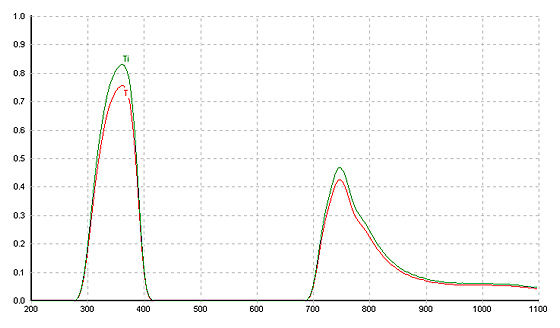
Figure 8. The curve of transmittance of the filter on the basis of Schott UG 1 [10]
According to some, as a combined filter can also act as two polarizing filter, rotated relative to each other so that all visible light is delayed [11].
When you create the UV and IR photos to achieve the desired effect, photographers often use a UV-pass, IR or a combination of filters to reduce the effect on the resulting image radiation in the visible range.
And finally, there is not much to tell about the separate technique of photographing the so – called pinhole photography. Pinhole is a simplified type of photographic designs: this is an unusual camera with no lens – it replaces the small hole (slit) having a diameter of about one millimeter. The clarity of the resulting image depends on the size of the cracks – the smaller, the sharper the image. Before these holes were made with a pin or needle, hence the name the art of photography. The image produced by a pinhole has an infinite depth of field, i.e. the objects located near and far away from the camera, the image will be transferred equally sharp. All objects, therefore, merge into one whole picture in which there is no division according to the plans. In this case the image often turns out a bit blurry, because of the need of installation of long endurance.

Figure 9. The image obtained by the pinhole [12]
As is clear from the description of the technology, the use of the pinhole allows to eliminate the influence of lens and filters on images and produce photos that have the effect of all spectral components of the radiation, which is capable to react the photosensitive element.
Conclusion
From the above we can draw the following conclusions:
- When shooting a regular film camera, you can record only the radiation of the near UV range. In order to capture the medium-and long-wave UV ranges, it is necessary to use special expensive lenses (or removed altogether without the lens, using the technique of "pinhole"). For IR photography, you must use a special film.
- When shooting with a digital camera, not subjected to intentional hardware revision, can be accessed (and even then not always) only the near UV range. If to remove from the camera mounted filter manufacturer hot-mirror, it becomes available for shooting in near IR range. Photographing in the middle and the far UV and IR ranges on the digital camera is impossible due to the limited spectral sensitivity of the CCD.
- In order to get the photos only in the UV and/or IR ranges, it is necessary to eliminate visible radiation with special filters.
This implies that most of the available photographs was the image derived from radiation in the visible and near UV ranges. The radiation of other wavelength (IR, UV-C, UV-b) can affect the image only if the photographer made for this purpose any efforts – modified camera that used special film or lens.
In the next article in this series, we consider the features of images taken in the UV and IR wavelength ranges.
Translated by «Yandex.Translator»
Log in or register to post comments
